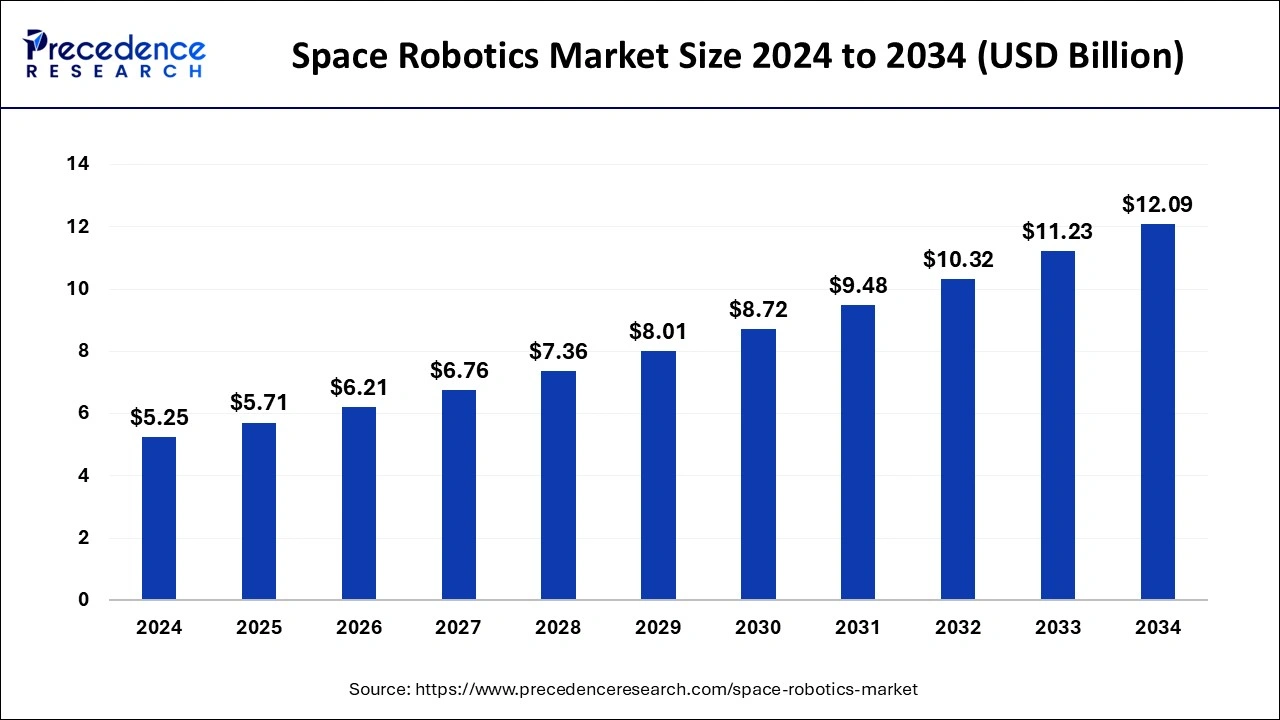The global space robotics market size accounted for USD 4.82 billion in 2023 and is anticipated to rake around USD 11.23 billion by 2033, growing at a CAGR of 8.83% from 2024 to 2033.
Key Points
- North America dominated the market with the largest market share of 56% in 2023.
- By solution, the remotely operated vehicles segment has held the largest market share of 38% in 2023.
- By application, the near space segment has contributed the largest market share of 41% in 2023.
- By organization, the government segment has generated more than 71% of market share in 2023.

The space robotics market is witnessing remarkable growth, driven by an increasing focus on space exploration, satellite servicing, and the emergence of new space technologies. The market is propelled by a combination of factors, including advancements in robotics technology, rising demand for satellite maintenance and repair, and the growing need for cost-effective solutions in space missions. Moreover, the utilization of space robotics for tasks such as asteroid mining, planetary exploration, and infrastructure maintenance further amplifies market growth prospects.
Get a Sample: https://www.precedenceresearch.com/sample/4009
Regionally, North America dominates the space robotics market, owing to significant investments in space exploration by government agencies like NASA and private space companies such as SpaceX and Blue Origin. The presence of leading robotics and aerospace companies in the region also contributes to its market leadership. Europe follows closely, supported by initiatives from the European Space Agency (ESA) and collaborations between European nations and private entities.
Space Robotics Market Scope
| Report Coverage | Details |
| Growth Rate from 2024 to 2033 | CAGR of 8.83% |
| Global Market Size in 2023 | USD 4.82 Billion |
| Global Market Size by 2033 | USD 11.23 Billion |
| U.S. Market Size in 2023 | USD 1.89 Billion |
| U.S. Market Size by 2033 | USD 4.40 Billion |
| Base Year | 2023 |
| Forecast Period | 2024 to 2033 |
| Segments Covered | By Solution, By Application, and By Organization |
| Regions Covered | North America, Europe, Asia-Pacific, Latin America, and Middle East & Africa |
Space Robotics Market Dynamics
The key drivers fueling the growth of the space robotics market include the increasing demand for satellite deployment and maintenance. With the expanding satellite constellation deployments for communication, navigation, and Earth observation purposes, the need for efficient robotic systems for assembly, inspection, and repair tasks is escalating. Additionally, advancements in artificial intelligence (AI) and machine learning (ML) are enhancing the autonomy and decision-making capabilities of space robots, enabling more complex and diverse missions.
Opportunities in the space robotics market abound, particularly in the field of on-orbit servicing. As satellites and space infrastructure age, the demand for servicing missions to extend their operational lifespan or perform repairs is expected to rise. Moreover, the emergence of commercial space ventures and the increasing participation of private companies in space exploration present new avenues for space robotics applications, including lunar and Mars missions, space tourism, and in-space manufacturing.
However, the space robotics market also faces several challenges that warrant attention. One of the primary concerns is the high cost associated with developing and deploying space robotics systems. The intricate nature of space missions demands robust and highly reliable robotic solutions, leading to significant investments in research, development, and testing. Moreover, the unpredictable nature of space environments, including radiation exposure, extreme temperatures, and microgravity, poses technical challenges for designing and operating space robots effectively.
Furthermore, regulatory and legal frameworks governing space activities present hurdles for the commercialization of space robotics services. Issues related to space debris mitigation, spectrum allocation for satellite communication, and intellectual property rights in space technology are areas of contention that need to be addressed to foster a conducive environment for market growth. Additionally, geopolitical tensions and international collaboration constraints could impact the accessibility of space resources and hinder the expansion of the space robotics market.
Read Also: Neuroendoscopy Market Size to Worth USD 260.49 Mn by 2033
Recent Developments
- In February 2024, an Autonomous Robotic Arm System aimed to advance space station robotics.
- In January 2024, ABB expanded its leadership in next-generation AI-enabled mobile robotics through the acquisition of Sevensense.
- In June 2023, Intrinsic and Siemens collaborated to accelerate the integration of AI-based robotics and automation technology.
- In July 2022, NanoRacks and GITAI partnered for the second in-space demonstration of a robotic system on the ISS.
Space Robotics Market Companies
- ALTIUS SPACE MACHINES.
- ASTROBOTIC TECHNOLOGY
- BluHaptics, Inc.
- Honeybee Robotics
- Intuitive Machines, LLC.
- MAXAR TECHNOLOGIES
- Metecs, LLC.
- Motiv Space Systems, Inc.
- Northrop Grumman.
- Oceaneering International, Inc.
Segments Covered in the Report
By Solution
- Remotely Operated Vehicles (ROV)
- Rovers/Spacecraft Landers
- Space Probes
- Others
- Remote Manipulator System (RMS)
- Robotic Arms/Manipulator Systems
- Gripping & Docking Systems
- Others
- Software
- Services
By Application
- Deep Space
- Space Transportation
- Space Exploration
- Others
- Near Space
- Space Transportation
- Space Exploration
- In-space Maintenance
- Others
- Ground
By Organization
- Commercial
- Government
By Geography
- North America
- Europe
- Asia-Pacific
- Latin America
- Middle East and Africa
Contact Us:
Mr. Alex
Sales Manager
Call: +1 9197 992 333
Email: sales@precedenceresearch.com
Web: https://www.precedenceresearch.com
Blog: https://www.expresswebwire.com/
Blog: https://www.uswebwire.com/
Blog: https://www.dailytechbulletin.com/
Blog: https://www.autoindustrybulletin.com/
